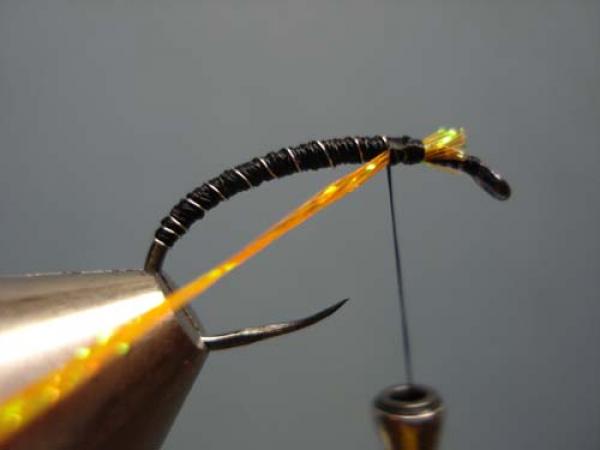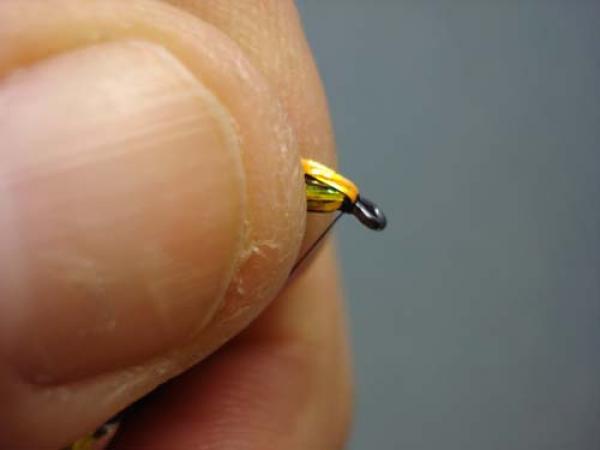Archives of Loren Williams Fly Tying Tutorials.
Superglue Buzzer
Fly and Photos by Loren Williams
"Buzzer" is a UK term for what we call "midges," so-named for the "buzzing" sound a swarm of large Diptera adults can make. This pattern imitates a buzzer pupae, what we would call a chironomid, or midge pupae.
Midges, no matter what you call them, are a year-round staple in a stillwater trout's diet and must be well represented in the stillwater angler's arsenal. This pattern is one of the better all-round chironomid patterns available for a few reasons. First, the thing is easy to tie! Next, the materials, or viable substitutes, are easy to obtain. Last, it catches fish and hold up well to repeated catches.
The reason this fly catches so well, evidenced by it's place in every European angler's stillwater box that I have ever met, lies in it composition. Midge pupae are very slim creatures, very much larger then most give them credit at being, which rise from the silty lake bottoms to the surface by using abdominal beats, followed by pauses. As they rise to the surface they take on a very distinctive sheen as trapped gasses reflect light. Orange-tinted wing buds swell as the adult prepares to emerge. The Superglue buzzer accurately hints at all these triggers, while it's super slim profile and slick glue coating permit the angler to fish it at depth on a floating line where he can mimic the rise to the surface.
This Buzzer also fishes well as a searching nymph on any sunk line from Midge Tips through Di7's, singularly or as a dropper, on the point or on top. If I was limited to but a few lake patterns this would assuredly be one. It shines brightest fished static on a good ripple where the wind does the work.
MATERIALS
Hook: Shrimp or Scud #10-#16 (shown is Knapek P)
Thread: To suit desired body color
Rib: Fine SS wire
Cheeks: Fine Orange Lagartun Braid
Click on photos to enlarge!

Place the hook firmly in your vise.

Begin to lay a base of thread all the way down, well around the hook bend.

Select some fine silver wire, I prefer stainless since I do not lose many lake flies.

Secure a strand to the back side of the hook, affixing it from the eye to the rear edge of your thread base. You are aiming to keep the body smooth.

Build a thin, slightly tapered body of tying thread. Buzzer proportions are a tad different than mayfly nymphs, the eventual thorax will be about the first third of the fly. I show the back side of the hook here because it is typically where gaps in your thread wraps will show. I wrap only enough thread to cover the secured section of the wire.

Counter-rib the wire in ever-widening turns. Last pass goes in front of the thread and under the hook.

As the wire is pulled to the rear, two turns of thread lock it in place.

Clip the excess.

Select a spool of bright orange Lagartun braid. You can substitute with tinsel, goose biot, floss, candy wrapper or any other orange flashy material.

On the near side of the hook secure the braid at the front of the thorax and angle it down and to the rear. Bind it back to the rear edge of the thorax.

Repeat on the far side of the hook.

Build a slightly bulbous thorax with your thread.

Grasp both strands of braid and pull the up and forward.

Secure them in that position with a few wraps of thread.

Gather the excess and pull it back in one bunch.

Make a few more wraps to secure the now-doubled material to lock it in place. Clip the excess.

Build a neat head, whip finish, and clip the thread.

Almost done!

ocate some brush-one Superglue. Hard as Nails is a fine substitute.

Like a good painter, apply several THIN coats to the entire bug. This will make it bulletproof and allow it to slice through the water, it will also give it that sexy sheen.

A completed Superglue Buzzer.

Some color and size variations that I find effective. Notice I sometime add a wing case of holographic tinsel in addition to, or in place of, the cheeks. Be creative!